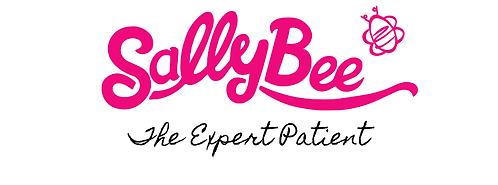Turn your Vulnerabilities into your Superpower!
- Sally Bee Team
- Sep 5
- 7 min read
Updated: Nov 28

Dear lovely you,
Below is an extract from the newsletter that has been sent out today to all members of The Recovery Club. I thought you might like to see what we talk about in the club...
Turning Vulnerability into your Superpower
This week on facebook we focussed on how to change your perspective around your fears, anxieties and vulnerabilities.
If you’ve ever been told to 'toughen up' or 'keep it together,' you’re not alone. So many of us grow up equating vulnerability with weakness.
We learn to protect ourselves by hiding our struggles, downplaying our needs or putting on a polished version of who we are.
But here’s the truth:
vulnerability is not weakness—it’s courage in motion.
When you allow yourself to be real, to let down the walls just a little, you’re doing something incredibly brave. You’re stepping into authenticity and in doing so, you create the very conditions that allow for trust, connection, and growth.
Why Vulnerability Feels Scary
At its core, vulnerability is about uncertainty and risk. It’s exposing something about yourself without knowing how it will be received. And that feels scary because your brain is wired to keep you safe, not to put your heart on the line.
But avoiding vulnerability comes at a cost. The masks we wear are heavy. The walls we build keep out hurt, but they also keep out love, intimacy and joy. When you live guarded, you miss the chance to be fully seen and accepted as you are.
Vulnerability as a Bridge
Think about the people who inspire you most. They’re rarely the ones who pretend to have it all together. They’re the ones who let you in. Who say, “I don’t have all the answers.” Who admit to stumbling, struggling and still showing up anyway.
That’s the paradox: the very thing we fear will push people away; our imperfections, our doubts, our struggles, is often what draws people closer. Vulnerability acts like a bridge, connecting your heart to someone else’s. It whispers: you’re not alone.
Three Ways to Make Vulnerability Your Superpower
Reframe it as courage.
The next time you catch yourself saying, 'I can’t share that, it’s too vulnerable,' try flipping it: 'Sharing this is an act of courage.' Strength isn’t about keeping everything together, it’s about being honest, even when it feels shaky. Write your thoughts down and look back at what you have written - regularly. I keep a Journal or notebook for such musings, take a look here to find some beautiful notebooks that are delivered straight to your door.
Lean into connection.
Vulnerability is the seed of trust. When you let yourself be seen, others feel permission to do the same. In relationships, in your work, or even within your own personal growth, honesty resonates far more than perfection ever could.
Practice self-compassion.
Being vulnerable stirs up self-criticism: What if I sound silly? What if I’m rejected?
That’s why compassion is key. Treat yourself with kindness when you take the risk of showing up real. Remember: you are worthy of love and respect, no matter how your vulnerability is received.
The Freedom of Living Open
When you embrace vulnerability, you unlock something priceless: Freedom. You stop exhausting yourself trying to maintain the 'perfect' version of you. Instead, you live aligned with your true self.
That authenticity isn’t just liberating, it’s magnetic. It attracts the right people, opportunities and experiences because they’re responding to the genuine you, not the mask.
A Final Reminder
The next time you feel yourself pulling back, afraid of being 'too much' or 'not enough,' pause. Take a breath. And remind yourself:
Vulnerability is not a flaw to hide. It is a superpower to embrace.
Because when you let yourself be seen, truly seen, you give others permission to do the same. And that ripple effect? That’s where real strength, real connection and real change begins.
If you haven’t yet, come and join us on Facebook (Follow page here) There’s still time to hop into the discussion and share your favourite mindset shift, or just read what’s resonated with others.
We’re in this together. One thought, one breath, one small, consistent habit at a time.
This Weeks
Zoom Coaching Session Catch-up
Breaking the Cycle: How to Stop Feeding Fear and Anxiety
Why This Matters
Fear and anxiety are part of being human. They’re survival tools, designed to alert you to danger and prepare you to act. But in modern life, anxiety often misfires. Instead of protecting you, it keeps you stuck in loops of worry, panic and overthinking.
The problem isn’t that fear shows up, the problem is how it gets fed.
Like a fire, anxiety grows stronger the more fuel you add to it. But once you learn what feeds it, you can stop giving it energy and let the flames burn out.
This weeks lesson was about identifying the cycle that keeps anxiety alive and practising ways to break free.
The Anatomy of the Fear-Anxiety Cycle
Think of anxiety as a wheel that keeps turning unless you put a stick in the spokes. The cycle often looks like this:
Trigger – Something sparks uncertainty: a thought, a sensation in your body or a stressful situation. Example: You feel a flutter in your chest.
Thoughts – The mind reacts with 'what if?' stories. Example: 'What if this means something is wrong with my heart?'
Body Response – The nervous system activates. Heart races, muscles tense, adrenaline spikes. Example: Now your chest feels even tighter.
Reaction – You try to manage it with avoidance, reassurance or control. Example: You Google symptoms or call someone to tell you you’re okay.
Reinforcement – The relief is short-lived, but your brain learns:'That really was dangerous, good thing I checked!' Which keeps the cycle going.
The cycle strengthens itself.
What keeps it alive is not the trigger itself, but the way we respond.
How We Feed Fear Without Realising It
Anxiety doesn’t just appear; it thrives on habits we often don’t notice. Here are some of the main 'fuels':
Avoidance – Skipping situations that feel risky (social events, travel, medical appointments).
Reassurance-seeking – Constantly checking with others or researching for certainty.
Overthinking – Replaying scenarios in your head, searching for perfect solutions.
Hypervigilance – Monitoring your body or environment for signs of danger.
Catastrophising – Jumping to the worst possible outcome.
Each of these responses makes sense, they’re attempts to feel safe. But long-term, they teach the brain that fear is necessary, which strengthens anxiety.
Shifting the Cycle – Tools to Break Free
Breaking the cycle doesn’t mean fighting anxiety head-on. Fighting tends to fuel it more. The goal is to respond differently, sending your nervous system the message:
'This is uncomfortable, but it’s not dangerous.'
Here are some strategies that work for me:
Notice Without Judgment
When anxiety flares, pause and label it: 'This is anxiety, not truth.'
Imagine you are the observer, not the participant. Your thoughts are weather passing by, not the sky itself.
Ground Your Body
Anxiety lives in the body, so calming the body interrupts the loop.
Try a 4–6 breath: Inhale for 4, exhale for 6.
Drop your shoulders, unclench your jaw and press your feet firmly into the floor.
Gently scan your body and release tension.
This signals safety and slows the nervous system.
Replace Avoidance with Approach
Avoidance strengthens fear. Approaching, even in small steps, weakens it.
Break a feared situation into tiny steps.
Example: If calling someone makes you anxious, start by writing their name, then dialling and hanging up, then saying a few words.
Small, consistent exposures retrain your brain: 'I can handle this.'
Pause the Reassurance Spiral
Instead of reaching for outside reassurance, practice self-reassurance:
“I can sit with this uncertainty.”
“I don’t need to know the outcome right now.”
This teaches your brain that you are capable of holding the unknown.
Anchor in the Present
Fear lives in the future; anxiety thrives on “what if.” Anchoring in the now pulls you back to reality.
Use the 5-4-3-2-1 method: 5 things you see, 4 you feel, 3 you hear, 2 you smell, 1 you taste.
Or, simply name aloud what you are doing: “I am washing the dishes, the water is warm, the plate is smooth.”
This interrupts spirals and reorients you to safety.
Rewiring the Message
Each time you respond differently, you’re retraining your brain:
Avoidance says: 'This is dangerous.'
Approach says: 'This is safe.'
Reassurance-seeking says: 'I can’t handle uncertainty.'
Self-reassurance says: ' I can live with not knowing.'
Catastrophising says: 'The worst will happen.'
Present-moment grounding says: 'I am safe right now.'
Neural pathways change with repetition. The more often you send a message of safety, the more your brain learns to relax.
Anxiety may always knock at the door, but you don’t have to open it. Each time you stop feeding it, the cycle weakens. Over time, your nervous system learns safety, your mind learns trust and your body learns calm.
Breaking the cycle isn’t about erasing fear, it’s about reclaiming your power to choose how you respond.
Anxiety is a signal, not a sentence.
You are not broken.
With practice, you can unlearn the patterns that keep fear alive and step into freedom.
With you always,
Sally Bee & The Recovery Club Team
The Next 2 Zoom Support Sessions are Now Bookable:
Thursday 11th September
11am - 12pm
The Power of Self Compassion
Thursday 18th September
11am - 12pm
Small Steps - Big Shifts. Building Momentum When Recovery Feels Stuck
Simply RSVP to the Zoom session HERE and you'll be sent the link to join!
And Finally...
As you head into the weekend, remember that fear and anxiety don’t need more of your energy, they quiet down when you stop feeding them.
Even one small shift; a deeper breath, a gentler response, a step toward what you’ve been avoiding, can interrupt the cycle and remind your nervous system that you are safe.
You don’t need to win a battle with anxiety; you only need to practice choosing calm over fuel.
Each choice you make is a step toward freedom.
With love (and a strong cup of tea)
Sally Bee x
Founder of The Recovery Club
Join The Recovery Club HERE






Comments